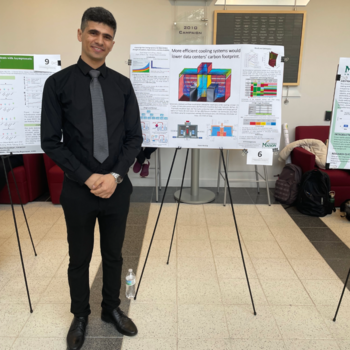In This Story
With data centers consuming about 2% of the world's electricity, their immense energy consumption and carbon footprint are a pressing concern in the technology sector. Sajad Kargar's research can help.
Kargar, a doctoral student in information sciences and technology, aims to reduce the carbon footprint of data centers by finding more efficient cooling methods for the structures.
“With Virginia being a hub for over 75% of the world's daily internet traffic, the potential to innovate in cooling solutions, whether through air, liquid, or a hybrid approach, presents a thrilling challenge,” said Kargar, whose dissertation research focuses broadly on two areas, air cooling and liquid cooling. “My aim is to drive forward technologies that not only enhance efficiency but also champion sustainability within this critical infrastructure.”
By incorporating concepts such as free cooling and evaporative cooling, Kargar aims to minimize energy usage and mitigate environmental impact without compromising cooling system performance.
Air cooling
Kargar has challenged conventional data center cooling methods by proposing a solution that harnesses natural elements, such as cold winter air, to enhance cooling efficiency. For example, in a recent award-winning presentation, titled “"Improving Free Cooling Systems for Data Centers,” Kargar demonstrated how the structure of data center buildings can facilitate natural convection, allowing hot air from computer systems to dissipate more effectively.

"By making the structure of the data center building itself act as a heat exchanger, we can utilize the cold outside air to cool the interior more efficiently," says Kargar. "This approach not only reduces energy consumption but also minimizes the carbon footprint associated with traditional cooling methods."
Kargar’s cooling system runs by itself when the temperature outside is cold enough; however, during warmer conditions, the activation of fans and humidifiers is necessary to efficiently manage humidity and air circulation, ensuring the system continues to operate effectively with significantly reduced power consumption compared to conventional systems.
“The performance of our system is several times better than the best case that is running in the world right now,” said Kargar. Structurally transforming data center buildings into heat exchangers as Kargar suggests would significantly reduce reliance on energy-intensive cooling systems, he explained.
Liquid cooling
Recognizing the limitations of air cooling, particularly with the rising density and heat output of modern computing systems, Kargar is also delving into liquid cooling, where he seeks to enhance heat transfer efficiency using micro- and nano-particles.
"As computing systems become more dense and powerful, traditional cooling methods are no longer sufficient," Kargar notes. "Liquid cooling offers a promising solution, and my research aims to maximize its effectiveness while minimizing energy consumption."
In collaboration with his advisor Jeffrey Moran, Kargar is exploring the intricate dynamics of nanoparticle-infused liquids for optimal heat dissipation.
In the 2023-24 academic year, Kargar has been on a role: He is the first author on a paper published in the Journal of Molecular Liquids, presented at a conference, passed his comprehensive exams, and defended his thesis proposal, all while managing a heavy courseload, noted Moran.
For the paper, “Molecular Dynamics Calculations of the Enthalpy of Vaporization for Different Water Models,” Kargar and Moran “investigated the six most common types of water molecule [Surprisingly, there are more than 25 different types of water molecule.] and did calculations to find which one of them is the best for the enthalpy of vaporization, which is also needed for cooling of data centers,” explained Kargar. Enthalpy of vaporization refers to the heat that the molecule absorbs as it changes from a liquid to a gas.
Practical experiments
Kargar's work isn't just theoretical; it's poised for practical experimentation soon. With plans to test his air-cooling system at local data centers, Kargar's research is on the brink of real-world implementation. His innovative solutions offer a glimpse into a more sustainable future, where data centers operate with a significantly reduced environmental footprint while maintaining peak performance.
